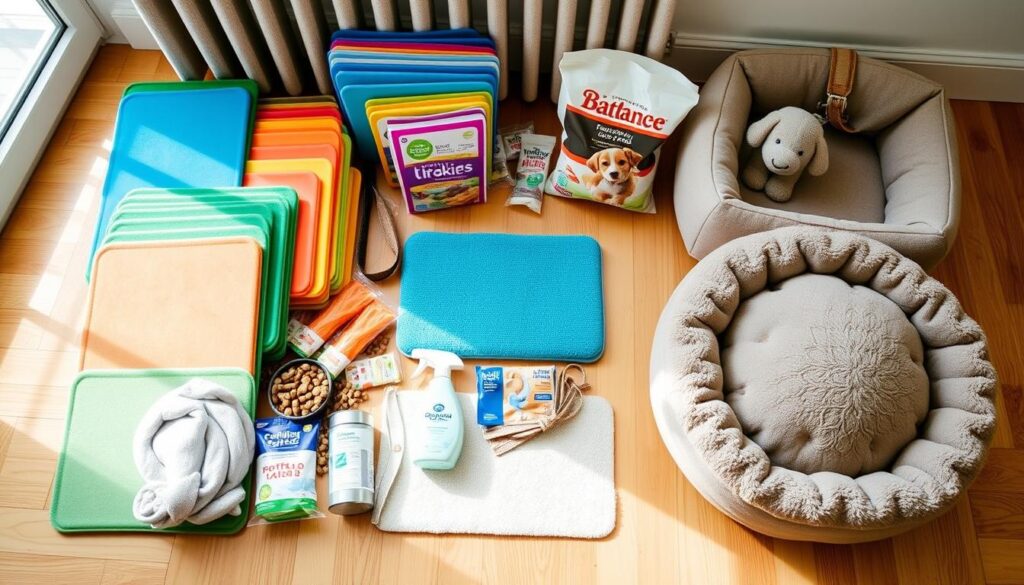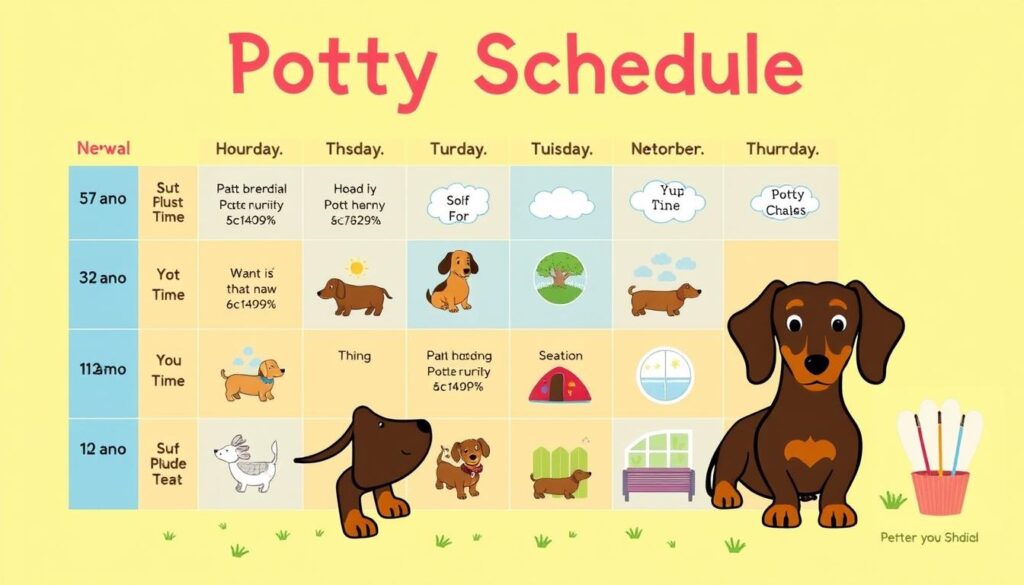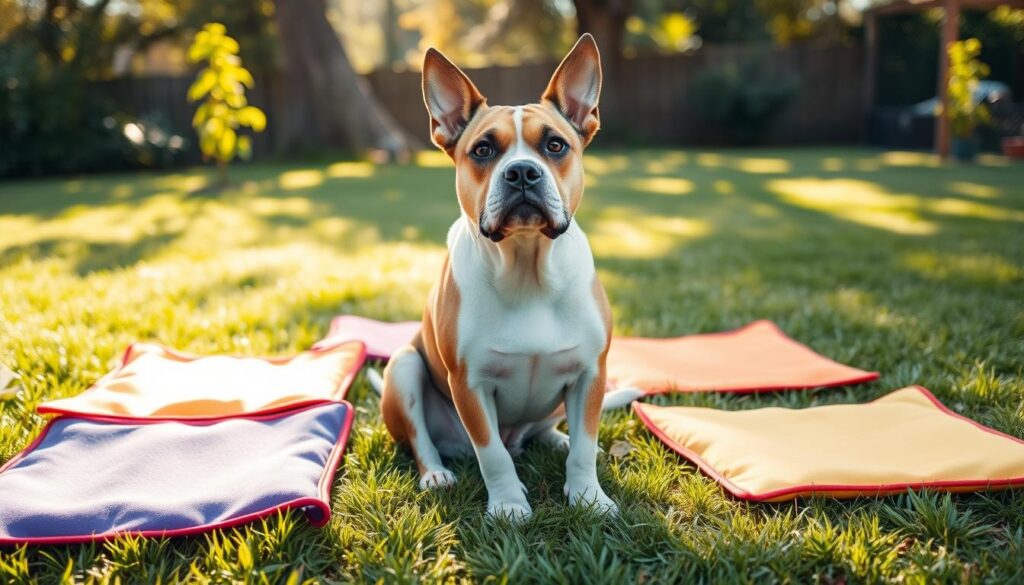Did you know 92% of dog owners struggle with potty training their stubborn pets? This statistic shows how common the problem is. I’ve seen many cases of house training issues, especially with stubborn dogs. In this guide, I’ll share effective techniques to help you potty train your stubborn dog. You’ll learn how to make your home clean and free from accidents.
Potty training a stubborn dog needs patience, consistency, and the right behavior strategies. By understanding your dog’s needs and using the right house training methods, you can overcome their resistance. This guide will help you, whether you’re dealing with a stubborn puppy or an adult dog.
Key Takeaways
- Understand your dog’s stubborn behavior to tailor your approach
- Establish a consistent routine for successful house training
- Use positive reinforcement to encourage desired potty habits
- Implement crate training as a valuable potty training tool
- Address common challenges specific to stubborn dogs
- Maintain patience and persistence throughout the training process
Understanding Stubbornness in Dogs

Stubbornness in dogs comes from many factors, like dog psychology and breed traits. Many pet owners think their dog is being obstinate when it’s really a mix-up in communication or unmet needs.
Defining stubborn behavior in dogs
Dogs seen as stubborn often ignore commands, resist new habits, or keep doing things they shouldn’t. For example, Rhodesian Ridgebacks are often called stubborn by their owners. But, this behavior might just mean they’re not getting the message right.
Recognizing underlying causes
Several things can make dogs seem stubborn:
- Lack of proper training or inconsistent routines
- Breed-specific traits, like independence in certain working breeds
- Fear or stress leading to avoidance behaviors
- Physical discomfort or pain influencing responsiveness
- Instinctual behaviors that are naturally rewarding for dogs
It’s important to understand these causes to tackle behavioral issues well. By knowing how genetics, training, and the environment play a part, we can help dogs use their natural instincts to our advantage.
| Perceived Stubborn Behavior | Possible Underlying Cause |
|---|---|
| Not coming when called | Lack of reinforcement for recall |
| Refusing to get off furniture | Inconsistent rules or lack of alternative comfortable spots |
| Ignoring the “sit” command | Insufficient training or distracting environment |
| Resisting pill administration | Past negative experiences or improper technique |
Preparing for Successful Potty Training

Getting ready for potty training is all about preparation and the right dog supplies. The right tools and a good routine make it easier for you and your dog.
Essential Supplies for Potty Training
First, you’ll need these important items:
- Crate: A safe spot for your dog when you’re not watching
- Leash: For walks outside
- Treats: To praise your dog for good behavior
- Cleaning products: For accidents
Establishing a Routine
Having a schedule is crucial for potty training. Set regular times for meals and potty breaks. This helps you know when your dog needs to go and builds good habits. Consistent training is especially important for puppies, whose bodies fully develop between 4 to 6 months.
Adult dogs can wait 6-8 hours to go to the bathroom, but puppies need to go more often. Be patient and use positive words and treats to encourage good behavior.
With the right supplies and a good plan, you’re ready for potty training. Remember, being consistent and patient is key.
Step-by-Step Guide to Potty Training a Stubborn Dog

Potty training a stubborn dog needs patience and the right dog training methods. I’ll share a detailed plan for housebreaking. It includes crate training, picking a potty spot, regular breaks, and using rewards.
Crate Training Basics
Crate training is great for potty training. Dogs don’t like to mess where they sleep. Cut down on water before bed to prevent accidents at night. Start with short crate times and increase them as your dog gets used to it.
Establishing a Designated Potty Area
Pick a special spot outside for your dog to go to the bathroom. Use a 10-foot leash to keep them safe during potty breaks. Always take them to this area to help them learn.
Frequent Potty Breaks
Take your dog out often, especially after eating, sleeping, and playing. Puppies need breaks every hour, based on their age in months. Adult dogs need breaks every 2-3 hours. Wait 20 minutes after they drink to know when they’ll need to go.
Positive Reinforcement Techniques
Positive training is essential for stubborn dogs. Praise and treat them right away when they go in the right spot. Don’t scold them for accidents. It can make them scared and slow down their learning. Clean up with an enzymatic cleaner like SCOE 10X to remove any smell.
Consistency is important. Stick to a routine by taking your dog out at the same times every day. With patience and these tips, even the most stubborn dog can learn to go potty where they should.
Crate Training Basics

Crate training is important for potty training stubborn dogs. The crate must be the right size. It should let your dog stand, turn, and lie down easily. For growing puppies, consider renting crates from animal shelters until they grow up.
Where you place the crate is important. Start with it near you at night, then move it to your preferred spot. This helps your dog feel less anxious and makes the crate a positive place.
Introducing the crate takes time. Use treats or favorite toys to get your dog to go in. It might take minutes to days, based on your dog’s personality. Start with short times and increase as your dog gets used to it.
Having a regular crate training schedule is crucial. Puppies under 6 months shouldn’t be crated for more than 3-4 hours. Feed meals in the crate to make it a positive place. Aim for at least six months of training for the best results.
| Crate Type | Best For |
|---|---|
| Wire | Dogs comfortable with open spaces |
| Kennel/Airline-style | Dogs preferring darkness |
Remember, crate training isn’t a quick fix. It can take days to weeks, depending on your dog’s age and past experiences. Stay patient, keep calm, and get professional help if needed.
Establishing a Designated Potty Area

I set up a specific outdoor potty spot for my dog. This is important in potty training a stubborn dog because by choosing a consistent location, I help my pet know where to go each time without thinking about it.
This approach keeps the yard clean. It reduces the spread of dog waste.
Training dogs to use a designated area takes time and repetition. I use treats as rewards and stay patient. For city dwellers or those with small breeds, an indoor potty area might be needed.
I use scent markers to make the spot more appealing. These markers guide my dog to the right place. Each time we visit, I use a specific command like “go potty”.
This verbal cue associates the action with the location.
| Dog Type | Average Training Time | Potty Break Frequency |
|---|---|---|
| New Puppy | Up to 6 weeks | Every 20 minutes when awake |
| Adult Dog | Varies (may take longer) | Every 4-6 hours |
| Small Breed | Longer than large breeds | More frequent breaks needed |
Cleaning up messes promptly is essential. It keeps the area clean and reinforces the designated area. Remember, scolding for accidents can lead to fear and mistrust.
Instead, focus on positive reinforcement when your dog uses the correct spot.
Frequent Potty Breaks

It’s important to take your puppy out often for potty breaks. I make a schedule based on my puppy’s age and needs. For Dachshund puppies between 8-11 weeks, I take them out every few hours.
As they get older, I adjust the schedule. At 12-14 weeks, it’s every hour. Then, at 14-16 weeks, it’s every two hours. Finally, at 16-18 weeks, it’s every 3-4 hours.
Knowing about puppy bladder control is crucial. I use the “age in months plus one” rule to figure out how long they can hold it. For example, a 3-month-old puppy can hold it for about 4 hours.
I take my puppy out after meals, naps, and playtime. These are the best times for them to go. It helps keep them clean and happy.
Watching how much water they drink is also important. I give them water every few hours during the day. But, I take it away 2 hours before bedtime. This helps prevent accidents at night and helps them sleep better.
| Age | Daytime Potty Frequency | Nighttime Potty Breaks |
|---|---|---|
| 8-10 weeks | Every 30-60 minutes | 1-2 times |
| 11 weeks | Every 1-2 hours | 1 time |
| 12+ weeks | Every 2-3 hours | Can usually sleep through |
I watch for signs like sniffing, circling, or whimpering. By responding quickly, I help them learn good habits. Remember, being consistent is of the upmost importance in potty training because with patience and a good plan, most dogs can learn by 6 months old.
Positive Reinforcement Techniques

Positive reinforcement is vital to potty training stubborn dogs. I use rewards to encourage good behavior and build lasting habits. This method praises and rewards your dog for using the right spot.
Verbal praise is a strong tool in training. When your dog uses the right spot, I give them lots of praise. This feedback links the right behavior with good results.
Treat rewards also work well. I have small, tasty treats ready for your dog after they go outside. This makes them associate going outside with good things.
Clicker training is great for stubborn dogs. I use a clicker to mark the moment they do the right thing, then give them a treat. This method clearly shows them the reward for their action.
- Offer immediate praise when your dog eliminates in the correct spot
- Use small, tasty treats as rewards for desired behavior
- Consider clicker training for precise timing of rewards
- Maintain consistency in your reward-based training approach
Consistency is crucial in reward-based training. I follow a regular schedule and always have treats and praise ready. With patience and persistence, even stubborn dogs can learn to use the potty correctly.
Monitoring and Supervision

Keeping a close eye on my dog is crucial to potty training success. I watch them all day, learning their potty signals. These can be sniffing, circling, or whining.
By being alert, I can stop accidents and guide them to the right spot. This helps a lot.
When I’m not around, I use a crate. It keeps them safe and stops accidents. As they get better, I give them more freedom. This makes them feel trusted and encourages good behavior.
Recognizing Potty Signals
It’s important to know my dog’s special signs. Adult dogs usually need to go:
- First thing in the morning
- Before bedtime
- After meals
- Following naps
I also watch for the “tinkle dance” to know when they need to go. Quick action helps avoid accidents. This is crucial for potty training.
Consistency in Routine
Consistency is very important. Dogs like routines, so I have set times for potty breaks. I use special words to make our routine faster.
This helps my dog know what to do and when. With constant watching, knowing their signals, and a routine, my dog is learning to use the potty. It’s a lot of work, but it’s worth it.
Handling Accidents Gracefully

Accidents are a normal part of potty training. It’s crucial to clean up accidents and remove odors to prevent them from happening again. If I catch my dog in the act, I calmly tell them to go to the potty area.
I use enzymatic cleaners for a deep clean. These products break down the molecules that cause smells, helping to keep dogs away from the same spots. Regular cleaners can leave scents that dogs find attractive.
I never scold my dog for accidents. Scolding can make them afraid to go potty, leading to more accidents inside. Instead, I reward them when they use the potty correctly.
Being consistent is important in preventing accidents. I take my dog out often, especially after meals, naps, and play. I also watch them closely indoors for signs they need to go.
If my dog is older or has health issues, I talk to a vet. Problems like diabetes or urinary tract infections can cause more accidents. Training Golden Retrievers or any dog needs patience and understanding.
Remember, accidents are a part of learning. With the right cleanup, positive rewards, and consistent training, your dog will learn to use the potty in time.
Addressing Common Challenges with Stubborn Dogs

Stubborn dogs can be tough during potty training. They might not want to go outside or forget what they learned. To solve these problems, we need to think creatively and keep trying.
Dealing with Resistance to Going Outside
To get a dog to go outside, make it fun. Use play or short walks to make the experience positive. This helps them want to go outside more and learn good habits.
Managing Regressions in Training
Even with hard work, setbacks can happen. If a dog forgets what they learned, go back to the basics. Also, watch them more closely. Keeping a regular routine helps them get back on track.
| Challenge | Solution | Expected Outcome |
|---|---|---|
| Resistance to Going Outside | Make trips enjoyable with play or walks | Increased willingness to go outdoors |
| Training Regressions | Return to basics, increase supervision | Gradual improvement in behavior |
| Inconsistent Progress | Maintain steady routine | Long-term behavioral changes |
Being patient is crucial when dealing with stubborn dogs. Addressing their behavior requires consistent training and positive rewards. Every dog learns at their own pace, so celebrate their small wins.
Enhancing Training with Additional Techniques

Advanced training methods can really help with potty training for stubborn dogs. I’ll talk about two great techniques: the umbilical cord method and scent association.
Using the Umbilical Cord Method
The umbilical cord method means keeping your dog on a leash inside. This way, you can watch them closely and catch any potty signals fast. It helps stop accidents and teaches good habits.
Incorporating Scent Training
Scent training is very effective. Dogs have a strong sense of smell. We can use this to teach them to go to the right places. This method is also used in other dog training techniques.
| Technique | Benefit | Implementation |
|---|---|---|
| Umbilical Cord Method | Constant supervision | Keep dog leashed to you indoors |
| Scent Training | Creates potty cues | Use specific scents in designated areas |
Remember, being consistent is crucial with these methods. With patience and effort, even stubborn dogs can learn to use the potty correctly.
Maintaining Consistency and Patience Throughout Training

Keeping up with consistency and patience is critical for potty training a stubborn dog. A solid training commitment leads to slow but sure progress. I will now talk about how to set up a routine and stay patient through it all.
Establishing a Long-Term Routine
Creating a consistent routine is vital for potty training success. Dogs follow habits well, so a routine helps them stay on track. Set regular times for meals and potty breaks to teach your dog when and where to go.
Training for 15-20 minutes a day helps reinforce good habits without overwhelming them.
Being Patient with Progress
Patience is crucial when potty training a stubborn dog. Remember, progress might be slow, but every small win is important. Avoid nagging or repeating commands, as it can slow learning.
Instead, use positive reinforcement to encourage good behavior. If your dog has setbacks, don’t get discouraged. Some breeds, like Shiba Inus or Jack Russell Terriers, need extra patience because of their independent nature.
To ensure long-term success, keep training in different places. This teaches your dog to behave in new environments. Clean up accidents right away to prevent them from happening again. Choose quiet spots for potty breaks. With consistency and patience, you’ll lay a strong foundation for your dog’s potty training.
Alternatives and Professional Help
When your dog is stubborn during potty training, you have several options. Professional dog trainers can create a plan just for your pet. They know how to tackle the unique challenges your dog faces.
When to Consider Professional Training Assistance
If your dog still can’t get potty training after trying hard, it’s time for a pro. Behavioral specialists can find out why your dog is stubborn. They might teach you to reward your dog right after they go outside.
This quick reward helps dogs learn to go potty where they should. It’s an important part of teaching them good habits.
Exploring Online Resources and Courses
Online courses can also help with potty training stubborn dogs. They give tips like keeping your dog out of the house and using crates. For example, a $9.99 course might share 13 potty training tips.
Some courses suggest taking puppies out every few hours. They say to follow the rule of one hour per month of age for bladder control.
Remember, patience is important in potty training. Whether you choose professional help or online courses, be consistent. Slowly increasing your puppy’s crate time can help them learn.
If your dog bites, getting help with biting behavior might be a good idea. With the right help and approach, even the most stubborn dogs can learn to behave well.


